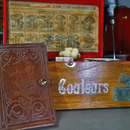Introduction: How I Made an Illuminated Booknook
One of the trends around at moment are Booknooks, not the corner of a library, but a small scene that is hidden within the space of a book. These can then be placed into your bookshelf to bring a little art and fun into life. Originally championed by {insert Japanese guy} there are now lots of people building little fantasy worlds and alleyways into book sized spaces.
I started with a freely available 3D model and decided to make it easier to print and also to contain the necessary LED's and electronics to spice it up a little.
Step 1: 3D Printing
To make this I used an existing 3D file that was found on thingiverse and made by FiveNights - www.thingiverse.com/thing:3239670
The only issue it was all in one piece and seemed a bit problematic to print, so I split it into two pieces and sculpted out spaces for lights, electronics and battery
Eventually by laying each side flat I got it to print satisfactorily.
Step 2: Test Fit and Battery Compartment
With it being lit, I wanted to use just a single AA battery and used a belkin battery holder, these are neat as they are fairly small and give a professional look to the finished article and removes the reliance on using USB power.
The battery holder is a Bulgin AA Holder
Step 3: Primer to Block Light
As there were going to be lights inside i used red primer as a base to help remove the glow from inside the model. I also had a load of this left over from a previous project :)
Step 4: Basic Colour Washes
With the painting, i used some acrylic black ink wash and followed this up with some grey wash as well. This would give a good base to the stonework and pooled nicely in all the cracks and crevices.
Step 5: Colour Detailing
Once dry I then brushed on some raw and burnt umber to give some more solid feel to the ground. I painted the minarets and roofs in a combination of tamiya acrylic blues, reds and greens.
The archway was painted using a gold leaf tamiya colour and some details like the stairs picked out in black.
Step 6: Plywood Frame
To give some weight and robustness to the finished booknook i added some 3mm ply to the back and bottom. This was just glued on.
Step 7: Adding Scenic Materials
With the paint now dry I added some scenic modelling materials. Green grass flock covered most of it and some forest shrubbery appllied as well for some bushes.
Step 8: Electronics
Here is a guide on how to wire up the electronics and run it off just a single 1.5v AA battery.
I used a single 1.5v to 5V booster and a AA battery holder with a sub-min switch. The LED's were 3mm coloured red, orange and yellow and of the flickering variety . I also bought them pre-wired with resistors to make things easier. .
Battery booster is a HW-626 : 0.9V-5V to 5V DC-DC Step-Up Power Module Voltage Boost Converter Board
https://rover.ebay.com/rover/1/710-53481-19255-0/1?mpre=https%3A%2F%2Fwww.ebay.co.uk%2Fitm%2F0-9V-5V-to-5V-DC-DC-Step-Up-Power-Module-Voltage-Boost-Converter-Board-Tools-UK%2F164054378647%3FssPageName%3DSTRK%253AMEBIDX%253AIT%26_trksid%3Dp2057872.m2749.l2649&campid=5338498334&toolid=20008
Step 9: Book Covers
To cover the sides of the book I used some sticky back vinyl and used 2mm chipboard as the base of the covers.
Step 10: Final Fitting
With everything ready I glued the two pieces of the nook together and then after sticking some black paper on the covers then glued these into place.
Step 11: The Book Nook
The Booknook came out better than i was hoping and now resides on the bookshelf as a nice surprise for anyone looking.













